In our previous article, we explored the history rise and fall of VR. It was Oculus who essentially brought about the rebirth of virtual reality in recent years. We’ve already seen in our previous articles that as a concept, virtual reality could technically be dated back to the nineteenth century, and there were numerous attempts in the twentieth century to bring virtual reality back to life. However, the technology has always been lacking, and there was never enough public interest in virtual reality to make it go mainstream.
This article on Oculus and the other VR contenders is part of our series of articles below on “VR for business”:
- The History, Rise & Fall of Virtual Reality
- Has Oculus Lost the First Generation of Virtual Reality to HTC
- How Marketers Can Use Virtual Reality
- Virtual Reality vs. Augmented Reality & the Applications for Business
- Open Source Virtual Reality and What This Means for Business
- Virtual Reality Web Design; Why Every Business Will Need to Factor VR into Their Digital Marketing
- Virtual Reality eCommerce & the Future of Online Shopping (vCommerce)
- The Lowdown from Our VR Gurus, Rob and Adam
We would love to encourage some discussion and debate around where this interesting and game-changing technology is heading, so please feel free to leave us a comment below or on social media and we’ll get back to you.
The Oculus Rift
The whole notion of VR changed in 2011 when Oculus started the virtual reality revolution again with their Oculus Rift. Palmer Luckey, the one who kickstarted the revolution, seemed like just the person to bring virtual reality back into the public eye. Still, Oculus and what they were trying to achieve wasn’t as hot a topic as perhaps it should have been. This all changed when Facebook acquired them in 2014 for over $2 billion.
Suddenly, virtual reality was firmly back on the map and clearly in the public eye. Yet some believe, including our own Opace virtual reality gurus Rob and Adam, that this ultimately caused Oculus’ downfall from the number one spot of virtual reality kings. It seems that they have become almost lazy, overtaken by other surprise contenders such as the HTC Vive, the cheaper Samsung Gear VR, and the PlayStation VR. As Adam says, “they’ve been complacent as they previously had no competition.”
Have Oculus lost the first generation of virtual reality?
Despite the fact that it may seem that Oculus somewhat took their eye off the ball, and it is widely thought that this was because they weren’t expecting any competition, the Oculus Rift is still a firm competitor in the virtual reality ring.
The Oculus Rift costs $599, which is roughly £410, which for many is a huge drawback of the headset. However, from this same article, we can see that early reviews for the Oculus Rift are essentially good with comments such as “the comfort of the device; its easy setup process… and the sheer wow factor of the VR delivered.”
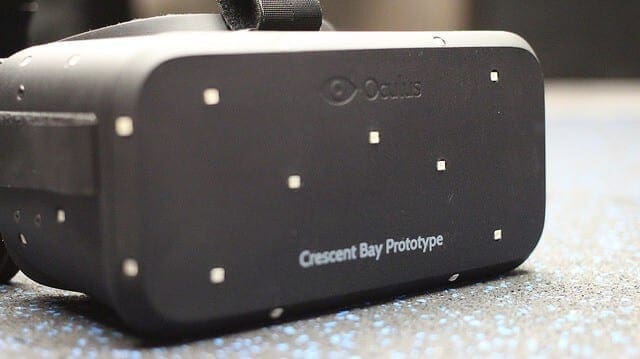
The Oculus Rift – credit: Maurizio Pesce
The Verge writes that “virtual reality is almost here” with Oculus, writing about its “clever and thoughtful touches” and Wired says that “there are no pain points, even after long sessions”. All in all, it would seem that the Oculus has received good reviews, albeit slightly disappointing with many citing that buyers may need to wait a little longer for the games and software that they desire. But what about its uses for business?
The Oculus Rift is more designed for a gaming experience and not so much for businesses or marketers. The Oculus Rift doesn’t have full room tracking at this stage, meaning movability is extremely limited, which would be an issue for any businesses looking to turn their eCommerce website into a fully-fledged virtual store. There is a lot of hype working in Oculus’ favour, and its substantial support from Facebook ensures that it will always be a competitor in the market.
One business advantage that the Oculus Rift may have over other contenders through is, social media, as Facebook are now perfectly placed to merge the worlds of social media and virtual reality. Facebook have only just recently established their ‘social virtual reality team’, so it will be interesting to see just what steps Facebook takes with this, and how businesses will be able to utilise it in their marketing strategies.
The HTC Vive
The HTC Vive was somewhat of a surprise entry to the virtual reality race, but it has taken the tech world by storm. Partnering up with Valve, the creators of the well-known PC gaming platform Steam, they’ve managed to release a headset that as floored its early users with its “superb graphics and VR immersion.”
It has two tracked controllers, while the Oculus doesn’t have any, as well as full room tracking with 360-degree movement within the virtual reality environment. This increases the scope of the headset tenfold compared to that of the others as players can physically move around in the environment. This clearly benefits any industry that wishes to make a move into virtual reality, and businesses looking to market their products or create a virtual reality eCommerce store will be able to accurately produce this for people in their living rooms. This will in turn allow their consumers to interact on a greater level with the products they are looking to
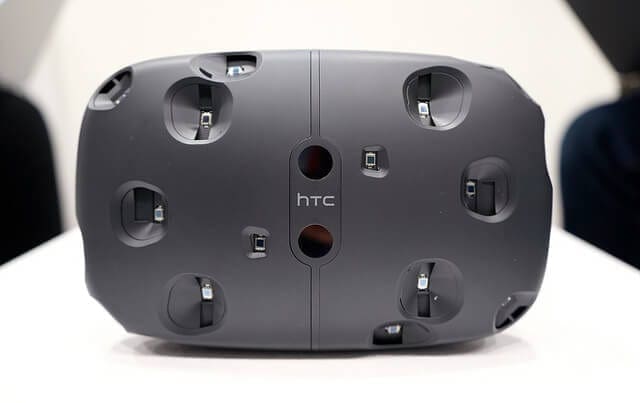
The HTC Vive – credit: TechStage
Both the Oculus Rift and the HTC Vive have been available for preorders, and despite the Vive being put up a month after the Rift, people have begun to receive the Rift while they still wait for the latter. To further rub salt in the wounds, Oculus have been shipping their headsets into BestBuy while they still have yet to fulfil all of their customer orders.
The HTC Vive, however, is currently priced at $799, which is roughly £550 and is more expensive than the Oculus Rift. Ultimately, reviews have said that you’ll certainly be paying for the extra features with this price tag, but ultimately it is worth it as the Vive is more “future-proofed with a front-facing camera, room-scale VR and two controllers bundled with the order.” It would certainly seem that the HTC Vive has more scope, and it will be interesting to see who edges ahead in the virtual reality race.
Sony’s PlayStation VR
Sony’s PlayStation VR, previously titled Project Morpheus, is also one to watch out for in the virtual reality race. Sony already has one competitive edge in this respect in that millions of customers already own a PlayStation 4 and the VR headset will slot nicely in alongside this. A headset like the Oculus Rift, on the other hand, will require you to purchase an “Oculus Ready PC” which can cost around $1499.
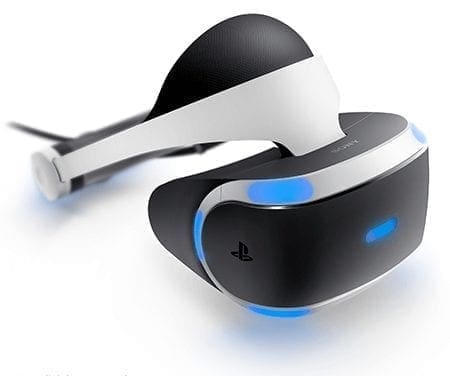
Sony’s PlayStation VR – credit: PlayStation.
Many have said that Sony’s PlayStation VR feels “more polished” than other headsets, with it having a 100-degree field of vision, which is less than the Vive, but an impressive 120 frames per second output. Sony has also made moves to reduce the weight that the headset will have, making for a much better experience throughout.
With Sony owning their own movie and television studios, and many of their customers already owning PlayStation 4s, the Sony PlayStation VR is perfectly placed to bring consumers closer together with virtual reality for both gaming and business. There is an almost limitless scope with what could be achieved here, and businesses like Amazon could make their in-store PlayStation apps virtual reality-friendly, allowing consumers to have an eCommerce experience quickly, and for much cheaper than the Oculus Rift or HTC Vive.
The Samsung Gear VR
The Samsung Gear VR was the first generation headset to go on sale and is priced at the moderate amount of $99.99. It’s so competitively priced as you simply place your phone within the headset itself, which then acts as the virtual reality screen. The only drawback is that you’ll need one of the later models of Samsung phone, Samsung Galaxy Note 5 or upwards, for it to work. Oculus are actually in colloboration with Samsung on this, so they have the technology and vision behind it as well.
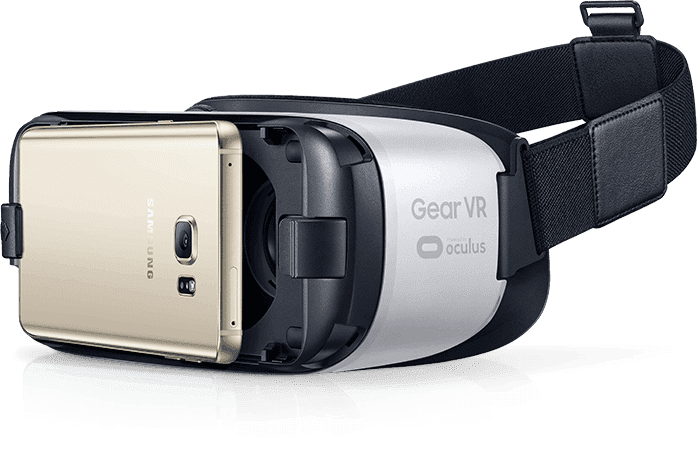
The Samsung Gear VR – credit: Samsung
The Samsung Gear VR isn’t anywhere near up to scratch compared to the others technically, but its price and compatibility with the latest Samsung smartphones, which many people own, is helping to bring virtual reality to the masses. Not to mention it’s light weight and mobility due to the absence of any wires are major advantages. Samsung of course also have a huge amount of funding which they can put into this. While the visuals may be lacking, businesses could make use of the fact that it is likely that many people will end up owning the affordable Samsung Gear VR. Given the vastly different approach that Samsung have taken, and most importantly the low cost, this is another serious contender in the VR race.
Google Cardboard
Finally, there is the Google Cardboard; the true virtual reality headset for the masses. Costing just $15 (yes, $15!), Google have gone down the complete opposite route to their technical counterparts, and have instead delivered a simple, yet somehow elegant cardboard virtual reality headset. It integrates with any Android phone, and the plan is quite simply to give as many people access to virtual reality as possible.
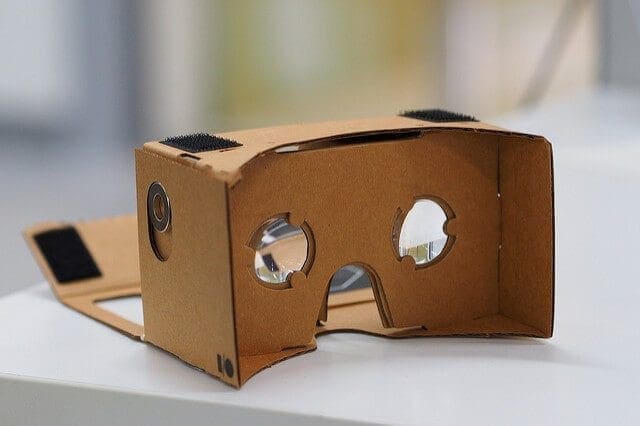
Google Cardboard VR – credit: Flickr
Of course, it’s obvious that the technology will be vastly outmatched by the other headsets, but it’s also an open source project, meaning developers can help push on what has been started by Google. Once Google has their foot in the door with mass consumer purchases, who knows where they could take the technology next. While this may not be the right headset for businesses attempting to showcase their products or services in the best possible light, Google is cleverly placing themselves firmly in the ring, ready for the future.
Our conclusions
Overall, it would seem that the Oculus Rift has certainly been knocked off its top spot as virtual reality kings. Back before Facebook acquired them, they were the only contenders, and even after the company purchase, no one seriously considered that anyone would be able to overtake them.
The HTC Vive was perhaps the biggest surprise entry, but their partnership with Valve and Steam make them a strong team with strong support behind them. The Samsung VR offers a great experience at a cost that many can afford. Unlike the others, it’s light weight and mobile, which provides them with a major advantage.
Ultimately each headset offers something a little different, but this is also where a large problem lies. They are all attempting to win the race alone without trying to combine their efforts. Apart from the Open Source Virtual Reality (OSVR) headset, which is compatible with the other systems, the other headsets are trying to be as exclusive as they can. While they aren’t fully exclusive, until there is one solid platform that businesses can reliably use for building virtual reality websites or eCommerce stores on, it is likely that all businesses will shy away from this and wait for a few big name brands to lead the way.






0 Comments